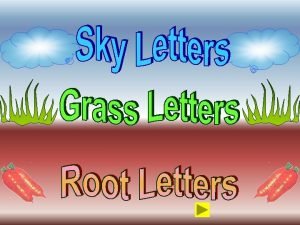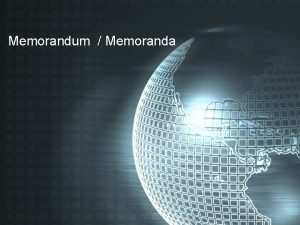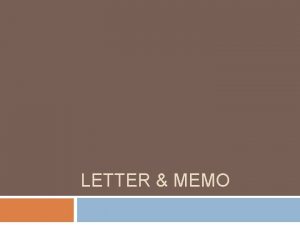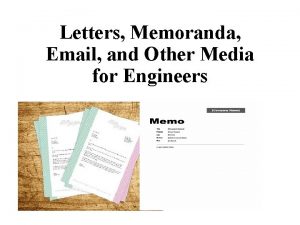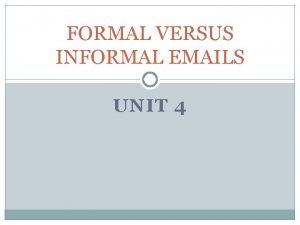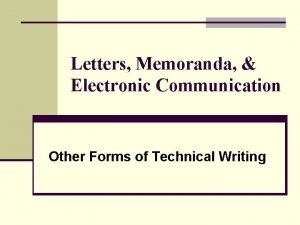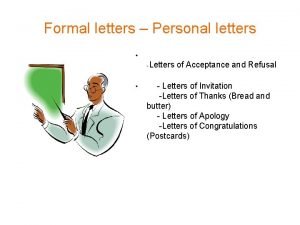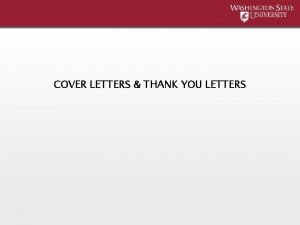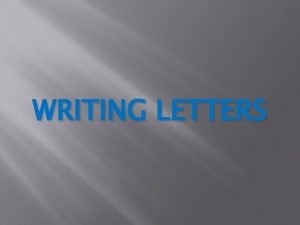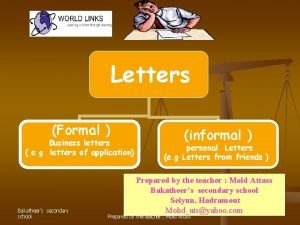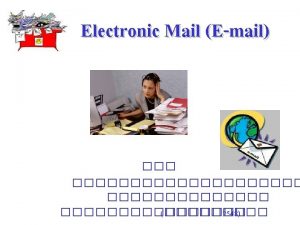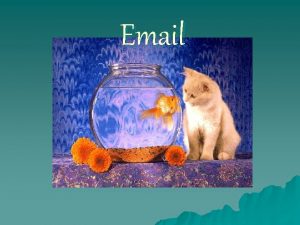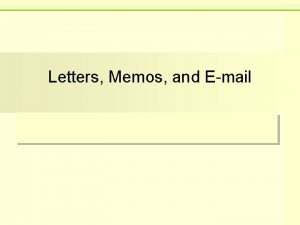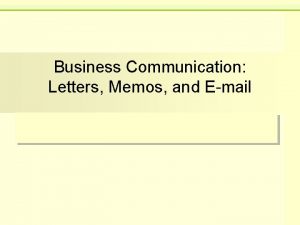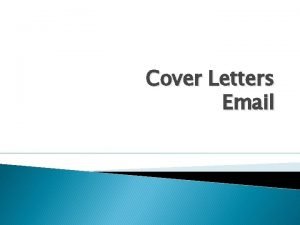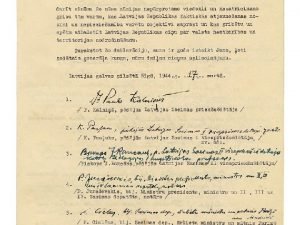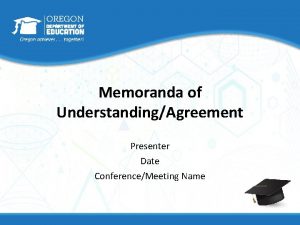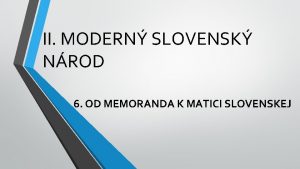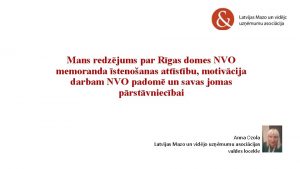Letters Memoranda Email and Other Media for Engineers




























- Slides: 28

Letters, Memoranda, Email, and Other Media for Engineers

As a professional engineer, you need to get familiar with the style, format, and organization of business communications

WHICH TO USE? • If you have a question for someone in your building, run down the hall and ask in person. • If it’s to someone within your organization but at a different location, send email or write a memo. • If it’s to someone external to your organization, send an email or text message or write a business letter. • If it’s urgent or informal, make a telephone call or send an email or text message

Phone, Text Message, or Paper?

• In telephone or face-to-face communication, these are the issues: 1. Permanent record: There is no record of what transpires in your phone conversation 2. Availability of the recipient: Mobile phones have reduced the problem known as ‘‘telephone tag. ’’ Still, recipients of a communication may not be in their offices or able to answer their mobile phone. 3. Attitude of recipients. Recipients may not take the phone, text-message, or in-person communication as seriously as they would if it were in writing. 4. Purpose, length, and complexity of the topic. Some topics are just too much for a conversation. For example, you can’t present details of product specifications or a proposal over the phone.

Email, Instant Messages, or Paper?

Email, Instant Messages, or Paper? Email and instant messages eliminate the bother of stamps, envelopes, and mailboxes—not to mention the delay in delivery and response. Unlike telephone communication, email doesn’t require its recipients to be in the right place at the right time—they can read it when they are ready.

Here are the issues to consider: 1. Recipients. Obviously, if recipients don’t have email, can’t readily access email, or just do not like it, printed letters or memos are necessary. 2. Need for reply or forwarding. If the letter or memo contains pages that the recipient must fill out and send, hardcopy may be preferable. 3. Security issues. As Ed Krol pointed out in The Whole Internet User’s Guide and Catalog in the early days of the Internet, you can assume that any email you send has a chance of being seen by anyone in the world. Think twice about sending confidential information (new product specifications, confidential data about a project, or sensitive information about a colleague) by email.

4. In-person discussion of the memo. If the message must be used in a face-to-face situation, print may be preferable. If everybody must print the memo for the meeting, you might as well send it in print and thus eliminate a potential snag. 5. Importance or length of the information. For some, even now deep into the age of the Internet, email lacks the feeling of settled, established information. It seems light, ephemeral—not a medium for serious business. Some people are less likely to take an electronic message seriously than they are a hardcopy memorandum or letter. 6. In-your-face factor. For some, a printed memo sitting on their desk just cannot be avoided. Of course, that depends—for some professionals, hardcopy mail is more inconvenient than email. Ultimately, you have to base your decision on which medium your colleagues are most in the habit of using.

Letters and Memos • Memo (memorandum) Written communication within an organization such as a business company, university, and government agency. • Business letter Written communication among members who are not in the same organization

Business Letters v Note that not all of the components are necessary to be included in each letter v. Face–to-face, telephone, and email communications are just not right for certain kinds of correspondence v Use a hardcopy letter 1. If you want to make sure that the recipient receives it and takes it seriously 2. If you want the recipient to study it at length 3. If the communication is long and packed with information 4. If you want a permanent record of communication

Business Letters – Standard Components • Company or personal logo Usually on the first page only. If you use sheet with logo, start your letter about 2. 5 cm below it • Heading Sender’s address and date. If you are using letterhead stationary, only the date is needed • Inside address Name, title, company, and address of the recipient • Subject line announce topic or purpose of the letter

• Salutation “Dear Sir/Madam: ” or “To Whom It May Concern: ” or “Dear Department members: ”, or… Where no obvious recipient exists or where the recipient does not matter, omit the salutation. It is better if you know exactly whom you are writing to, call the recipient’s organization (ask also for the title and the department name). “Dear Recruitment officers: ” Note that the salutation for business letters is punctuated with a colon. A comma implies a friendly nonbusiness communication • Body of the letter Single space text inside the paragraph, and double space between paragraphs

• Complementary close “Sincerely yours”, or “Best Regards”, or …etc. • Signature block This is a blank area for the signature, followed by your typed name, title, and organization. In professional correspondence, don’t forget to include these letters that identify the degree or title that you worked hard to earn • End notations Such as “Cc: ” and “Encl. : ” abbreviations come below the signature block. The first set is the initials of the sender and typist, respectively, “JMC”. Labels such as “Encl. : ” “Enclosure: ” or “Attachments: "indicate that other documents have been attached: “Encl. : specifications. ”

“Cc: ” followed by one or more names indicates to whom a copy of the letter was sent “Bcc: ” identifies “blind” recipients • If you receive a letter with “Bcc: ” at the bottom, the people whose names follow “Bcc: ” do not know that you received the letter, nor do they know that you know that they received the letter • Following pages If you use letterhead stationary, use the matching stationary (the same quality and style of paper but without the letter head)


Common Business Letter Formats Standard Block Letter • This is the easiest and most commonly used letter format • All elements are flush left • All serious communications use this format

Common Business Letter Formats Standard Semi-Block Letter • Similar to the block format except that the heading, complimentary close, and signature block are on the right margin

• The same as the semi-block format except that it adds a subject line and omits the complimentary close

Business Memoranda • For internal communication in an organization, use memorandum format 1. A call for employees to attend a general meeting 2. A reminder that status reports are due 3. A request to an employee to provide information • The actual contents of a memo can be very much like those of a business letter or like those of a short report

Business Memoranda – Standard Heading Date, To: , From: , and Subject Body of memo single spaced paragraph, and double space between paragraphs Complementary close some times not included Signature block


Email Writing • Make the email brief. No one like to read long pages on the screen • Make the subject line specific to make sure the email will be read • Important information at the beginning • Short paragraphs, and make spaces between them

Email Writing (Important Email Functions) � Save email into files or folders: Organize your sent and received email into meaningful folders. For example: ”clients, ” “staff, ” “projects. ” “friends & family” � Keep copies of email you send: You may need it later either because the email was lost or because you need to remember what you wrote in it � Use templates: if you have standard contents set up a template �Attach files for emails

� Search email folders: Know how to search email folders for topics or names of recipients and senders. � Create and use aliases and distribution lists: Increase your email efficiency by creating aliases (short abbreviations for email addresses) and distribution lists ( groups of related email addresses, such as those for staff or customers). � Use a signature: If you need to include your full name, title, organization, phone and fax numbers, …etc. In your email, set up a “signature”. It automatically pops that information into every mail you send or reply to.

Email Writing – Format and Style � Informality: Adjust the tone of your email according to the recipients and situation. Think twice about using humor, sarcasm, and informality with business clients and higher level managementespecially those whose native language is not English � Brevity: Email messages are normally rather short, under a dozen lines �Specific subject line: To ensure emails get read and has the desired impact, make the subject line specific and compelling �Important information first �Short paragraphs and space between paragraphs


Recommendations for Business Writings (for letters, memos, and emails) • Indicate the topic in the first sentence • Be brief and go to the point • Indicate any situation or preceding communication “based on last phone call” or “based on our meeting in the company” or “referring to your letter dated June 1 st , 2005” • Keep paragraphs short. Divide the communication to paragraphs when the topic changes • Use lists and paragraphs if necessary • Be clear if you expect any response form the readers
 Sky letters in english
Sky letters in english What is a memoranda
What is a memoranda Plural of memo
Plural of memo Dear engineers email
Dear engineers email Email format informal
Email format informal Self initiated other repair examples
Self initiated other repair examples Iso 22301 utbildning
Iso 22301 utbildning Novell typiska drag
Novell typiska drag Nationell inriktning för artificiell intelligens
Nationell inriktning för artificiell intelligens Returpilarna
Returpilarna Varför kallas perioden 1918-1939 för mellankrigstiden?
Varför kallas perioden 1918-1939 för mellankrigstiden? En lathund för arbete med kontinuitetshantering
En lathund för arbete med kontinuitetshantering Underlag för särskild löneskatt på pensionskostnader
Underlag för särskild löneskatt på pensionskostnader Personlig tidbok
Personlig tidbok A gastrica
A gastrica Vad är densitet
Vad är densitet Datorkunskap för nybörjare
Datorkunskap för nybörjare Stig kerman
Stig kerman Hur skriver man en tes
Hur skriver man en tes Delegerande ledarstil
Delegerande ledarstil Nyckelkompetenser för livslångt lärande
Nyckelkompetenser för livslångt lärande Påbyggnader för flakfordon
Påbyggnader för flakfordon Tryck formel
Tryck formel Svenskt ramverk för digital samverkan
Svenskt ramverk för digital samverkan I gullregnens månad
I gullregnens månad Presentera för publik crossboss
Presentera för publik crossboss Teckenspråk minoritetsspråk argument
Teckenspråk minoritetsspråk argument Vem räknas som jude
Vem räknas som jude Treserva lathund
Treserva lathund
